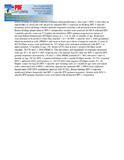| dc.contributor.author | John-Stewart, G.C | |
| dc.contributor.author | Mbori-Ngacha, DA | |
| dc.contributor.author | Payne, B.L | |
| dc.contributor.author | Farquhar, C | |
| dc.contributor.author | Richardson, B.A | |
| dc.contributor.author | Emery, S | |
| dc.contributor.author | Otieno, P, | |
| dc.contributor.author | Obimbo, E, | |
| dc.contributor.author | Dong, T, | |
| dc.contributor.author | Slyker, J | |
| dc.contributor.author | Nduati, RW | |
| dc.contributor.author | Overbaugh, J, | |
| dc.contributor.author | Rowland-Jones, S. | |
| dc.date.accessioned | 2013-04-25T14:15:08Z | |
| dc.date.available | 2013-04-25T14:15:08Z | |
| dc.date.issued | 2009 | |
| dc.identifier.citation | J Infect Dis. 2009 Mar 15;199(6):889-98 | en |
| dc.identifier.uri | http://erepository.uonbi.ac.ke:8080/xmlui/handle/123456789/16872 | |
| dc.identifier.uri | http://www.ncbi.nlm.nih.gov/pubmed/19434932 | |
| dc.description.abstract | Breast-feeding by infants exposed to human immunodeficiency virus type 1 (HIV-1) provides an opportunity to assess the role played by repeated HIV-1 exposure in eliciting HIV-1-specific immunity and in defining whether immune responses correlate with protection from infection.
Breast-feeding infants born to HIV-1-seropositive women were assessed for HLA-selected HIV-1 peptide-specific cytotoxic T lymphocyte interferon (IFN)-gamma responses by means of enzyme-linked immunospot (ELISpot) assays at 1, 3, 6, 9, and 12 months of age. Responses were deemed to be positive when they reached > or = 50 HIV-1-specific sfu/1 x 10(6) peripheral blood mononuclear cells (PBMCs) and were at least twice those of negative controls.
A total of 807 ELISpot assays were performed for 217 infants who remained uninfected with HIV-1 at approximately 12 months of age; 101 infants (47%) had at least 1 positive ELISpot result (median, 78-170 sfu/1 x 10(6) PBMCs). The prevalence and magnitude of responses increased with age (P = .01 and P = .007, respectively); the median log(10) value for HIV-1-specific IFN-gamma responses increased by 1.0 sfu/1 x 10(6) PBMCs/month (P < .001) between 1 and 12 months of age. Of 141 HIV-1-uninfected infants with 1-month ELISpot results, 10 (7%) acquired HIV-1 infection (0/16 with positive vs. 10/125 [8%] with negative ELISpot results; P = .6). Higher values for log(10) HIV-1-specific spot-forming units at 1 month of age were associated with a decreased risk of HIV-1 infection, adjusted for maternal HIV-1 RNA level (adjusted hazard ratio, 0.09 [95% confidence interval, 0.01-0.72]).. Breast-feeding HIV-1-exposed uninfected infants frequently had HIV-1-specific IFN-gamma responses. Greater early HIV-1-specific IFN-gamma responses were associated with decreased HIV-1 acquisition. | en |
| dc.language.iso | en | en |
| dc.title | HV-1-specific cytotoxic T lymphocytes and breast milk HIV-1 transmission. | en |
| dc.type | Article | en |
| local.publisher | Department of Paediatrics, University of Nairobi, Nairobi, Kenya | en |


